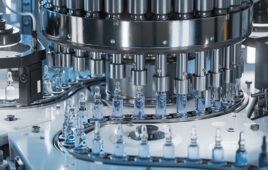
New Oceanside facility rendering. [Image courtesy of Genentech]
The announcement of the new plant follows last year’s opening of a new clinical supply center at its South San Francisco birthplace.
In a recent interview, we spoke with Nazeli Dertsakian, general manager of Genentech’s Oceanside facility, about the technology and sustainability features of the new biologics manufacturing facility. Dertsakian shares insights on using predictive analytics and robotics to enhance manufacturing operations and how the facility’s Industry 4.0 vision will optimize molecule design.
The responses have been lightly edited for brevity.
Can you give a brief overview of your background at Genentech?
Nazeli Dertsakian: I’ve been with Genentech for over eight years, and I’ve been the general manager for about five years. My role involves:
- Overseeing all operations, which includes manufacturing.
- Bringing new molecules into the facility for manufacturing.
- Ensuring quality and making sure our medicines are safe for patients.
I’m responsible for transportation, supply chain and small-scale experiments with our development colleagues in South San Francisco.
We are located in Oceanside, where we have 60 acres of land. Currently, our manufacturing facility occupies 30 acres of the land. Our current infrastructure includes laboratories, office buildings, warehouse space and conference rooms. With the new building, we will have additional manufacturing capabilities on campus. In addition, this new facility will allow us to expand our operations and take advantage of other on-site opportunities.
Can you describe the technology that will be incorporated into the new Genentech biologics facility?

Aerial view of Genentech’s Oceanside campus [Image courtesy of Genentech]
With the modular aspect of the facility, we can move from one product to another more or less instantaneously and produce small batches of multiple products simultaneously. This allows us to produce different types of medicines faster and with more diverse types of medicines than before.
The proximity to our development colleagues in South San Francisco at the clinical supply center will enable us to move the product from the clinical to the commercial stage in a matter of days rather than months or years.
Using digital technologies also will make our manufacturing process more robust, predictive and efficient.
The new facility also provides opportunities for our existing workforce to learn new skills and diversify their skill sets.
How big of an employer is Genentech in Oceanside currently?
Dertsakian: We are currently the largest employer in north San Diego County and Oceanside from a manufacturing facilities perspective. We have around 450 full-time employees at the site. With the addition of the new facility, we will hire 150 employees.
We work closely with the County in the community space. Our workforce will continue to grow, and we are committed to creating employment opportunities that benefit the community.
We will have a diverse range of roles in this facility, similar to what we have in our current operations. This will include people at all levels of education and experience, including data engineers, automation engineers, data scientists, equipment engineers and material scientists who understand the process and materials we work with. We will also have manufacturing technicians and analysts who work daily with the process. We anticipate having a good combination of varying skills and education levels in this facility.
What type of sustainability features will the plant feature?
Dertsakian: Sustainability is one of our top priorities as part of our corporate goals. The new facility’s design will reflect this commitment, both in terms of the construction materials and the operational practices we will implement. We plan to reduce energy utilization by 25% and generate 100% of our electricity from renewable sources.
We have already installed many solar panels in our existing infrastructure, generating around 22% of our current energy utilization. We also plan to reduce water utilization by 28%. Additionally, we are committed to eliminating plastic waste in landfills in our existing production and the new facility. We have established recycling and down-cycling programs and are exploring other circular economy solutions that align with our corporate goals. We are also working toward obtaining LEED Gold certification for the new facility.

Another aerial view of the Oceanside site [Image courtesy of Genentech]
Can you describe the construction process for the plant?
Dertsakian: The construction is scheduled to be completed by the third quarter of 2024. We are also expediting the facility’s integration into our operations by completing various tasks in parallel with the construction process. For example, we are ordering the process equipment and installing and qualifying utilities. By the time construction is complete, we will be ready to qualify the facility for GMP production, meaning it can be licensed for producing commercial medicines and meet regulatory agency standards. We also have access to highly automated systems and digital technologies, which require thorough qualification to ensure that all systems are working together as intended and meet regulatory expectations. Qualification activities will take place from 2024 through 2025, with the fully qualified GMP facility expected to be up and running in early 2025.
What types of analytics technologies will be featured in the new facility?
Dertsakian: We plan to use predictive analytics to monitor our processes and detect any failure modes that may impact the quality and efficiency of our operations. With these analytics in place, we can adjust our processes and improve the quality output from our operations. The speed of our operations is also improved through digital technologies that facilitate the transfer of information between our clinical supply center and manufacturing operations with a touch of a button. We can transfer methods, automation recipes and formulations of molecules. The use of analytics makes our operations more predictable and helps prevent errors. We also plan to use robotics to minimize manual and redundant operations while eliminating ergonomic concerns and improving the overall efficiency of our manufacturing facilities.
Industry 4.0 is at the forefront of our vision for how we will operate the facility. We are not only looking at digital tools and technologies but also at how we can optimize the design of our molecules. By combining these two elements, we can produce innovative medicines with the help of predictive digital technologies. For example, we will build multivariate data analysis tools into our automation system to continuously monitor the process and use the data to make adjustments and ensure we get the best output from our molecules.
Filed Under: Biologics





Tell Us What You Think!
You must be logged in to post a comment.